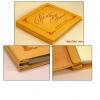-
Posts
1,311 -
Joined
-
Last visited
Content Type
Profiles
Forums
Events
Blogs
Gallery
Everything posted by Rawhide
-
I know, I know
-
Tandy does carry an awl installed in a haft already...See here However Bob Douglas makes the best damn blades on the planet. His info is on the suppliers page.
-
I lined mine with som really soft chrome tan. I think as long as you line them with some form of leather, you'll be fine.
-
Jim, I sure will... I actually saw him yesterday...he was working on a pattern for our class this weekend. So I'll see him tomorrow and Sunday. This will be good, 'cause I love to mess with Ron.
-
muuhaahaa!!! We got another one!!!!
-
Jim, The blade is the slim one I think. It is 2mm across the flats, and 3mm across the cutting edges, which translates to roughly .078 x .118 and about 1.2 inches long (past the ferrule), so more than likely it's at least 1 3/4 to 2 inches or so long. My Peter Main awl is about 1.3 mm across the flats and 2 mm across the cutting edges, which is about .050 x .078 and about 1 inch long past the ferrule. Here's a picture of the blades next to a penny for comparison. The Peter Main blade is on the left, and the Bob Douglas is on the right.
-
Jim, I use my Peter Main blade for stitches 8 spi and above. Click here (post #8) to see a comparison with holes sizes I posted a while back. I can measure it if you want when I get home.
-
I took the liberty of asking...just in case anyone else had the same question.... ...yes, all is glued. Look at any album in stores and you will find they are 'glued'. The outer cover is glued (with contact cement) only around the edges, as there is foam padding under both front and back covers. The goatskin lining (skived to a feather edge) is glued with 'white glue' (Elma's style). I have used this as excess glue can be cleaned up with damp rag (with water of course). Glueing such a fine edge with a contact cement is not practical. Peter
-
Glad you could join us here... we love to have suppliers in on these discussions...it helps to clear up both sides of the quesitons. My james awl did come sharp, but not nearly sharp enough...I had to work on it for a little while. Not as long as I had to work my Osborne though...I have the curved James awl, so maybe that's the difference. The only awls I have ever purchased that didn't require any work were Bob Douglas and Peter Main's. Osborne is famous for not grounding the edges down, so that the consumer can easily put their own bevel angle in place without a lot of rework...
-
I've got all three, a John James, an Osborne, and a Bob Douglas. I think that the Osborne would be better for shaping and sharpening. The James is harder to sharpen for me. Regardless of what's said mine (James, nor Osborne), came ready to use. My Douglas did though...It's like going from dial up to high speed...at first the price sucks, but then you can't live without it.
-
I think it's only glued. I know he likes the leather cement a lot, but I'll ask if you'd like to know.
-
Peter taught me how to do this about a year ago and I did it to one of my scalpel handles. It helps in the grip of it tremendously. Glad he decided to put it in print.
-
At least for the Roo, it's veg-tan... the veg is much stronger than the chrome...I'm not sure if the same applies to cow/calf.
-
Ricky, I usually make my own, but I use kangaroo hide. I usually split it down to about 1-2 oz or less after I cut the thongs.
-
Damn it Bob! I thought you were my friend...Now you go and complicate things.
-
Man, now I'm interested... I actually made one of those 4-sided strops for myself a while back, I use 800/1200/2000 grit wet/dry on three sides and a rouge loaded strop on the 4th side. Works great.
-
Not Peter (even though I post for him quite often), but Are you refering to the lettering? Looking at it in a very high level, the lettering done by tracing the outlines of the letters to damp vegetable tanned leather. Then the lines are cut with a swivel knife, and Peter usually does inverted carving which means he bevels on the inside of the cut. He uses a modeling tool to accomplish this. Once he has the look of the letters, they are dyed with spirit dye, then the piece is usually oiled, and then sealed. Marlon
-
Because Tandy is a corporate owned entity and everything they sell probably has to be approved by some team (probably board of directors)....Probably the same reason they don't sell any custom maker tools like hidecrafters. It's much more cost effective to supply one kind of rouge than to stock more expensive ones...
-
The only problems I see with that solution TF is that it's 3 times as expensive and it is a 9.0 micron compound whereas the green one i use is a 0.5 micron compound.
-
...here is a photo album just completed. It is made from 2-3oz leather, with turned edges, and has goatskin lining the covers. The spine has a cover, and the screws that hold the pages are concealed on the inside. It is all carved inverted style, and is colored with spirit dyes. ...I have put a cardboard 'spacer' between every third plastic sleeve....this will eliminate the pages fanning out when photos are added, allowing the folder to always lay flat. Peter
-
I stopped using the tandy rouge and started using a micro hone that's got a waxy/grease base and is soft at room temp. See it here.
-
This is a simulated braid tool. I don't have an example though to show you how to use it.
-

Orange Dye
Rawhide replied to Dags3777's topic in Dyes, Antiques, Stains, Glues, Waxes, Finishes and Conditioners.
I've dyed some lace orange, but I just used Fiebing's orange dye. No need to mix something that's already made. -
Hi Grumpy... It's nothing you're doing.. It's the thread...I had the exact same problem when I started and tried everything from not pulling too tight to rubbing the cord with brown paper bag. The thread you are using sort of stretches when you pull tight and for whatever reason looks grey (plus it's usually way too much wax on it). Use non-waxed linen thread and wax it yourself, you'll see a big difference.
-
Thanks Crystal! Brass tacks: I do use a groover (Bob Douglas Versa Groover), however, I don't try to groove too deeply... I feel that the stitch should sit about a mm or two mm below the surface... this will keep the leather from folding over on the stitches when you slick the edges. (The closer you are to the edge, the more this matters, i.e. belts.) I use Barbour's Linen Flax Thread (non-waxed) for all my hand stitching...I know a lot of folks use nylon, but I prefer the linen. I wax it myself with beeswax and I have yet had the cord fail...I've had leather fail before the cord. On the bag itself, I used a Gomph 6 stitch per inch overstitch wheel to layout my hole locations with a Bob Douglas slim awl (on the handles and attach shields I used 8 spi, with a Peter Main awl). (I do it the old fashioned way like Al Stohlman, one hole at a time) The key is to do the exact same thing each hole... I stitch toward me and begin by piercing the hole (with right hand), then insert the left hand needle, pull through a little then I pull that same short piece of thread up into the corner of the diamond...then insert the opposite needle 'under' the thread already in the hole in the opposite corner of the diamond if you will, then pull the stitch up tight. You have to be careful to always do it the exact same way, or a stitch will look out of place. When I'm all done, i use the overstitch wheel again to run over the stitches back and forth and it helps seat them well. Hope this helps...






